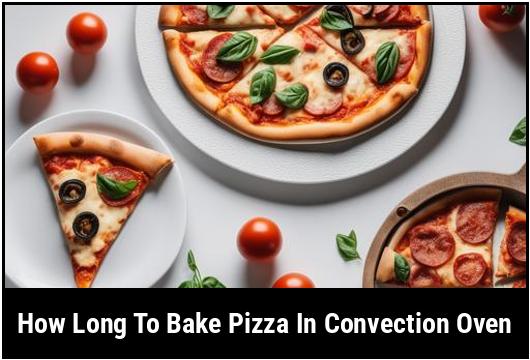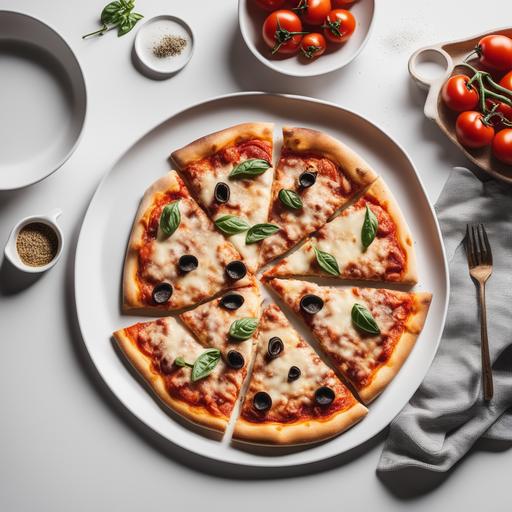[GUIDE] How Long To Bake Pizza In Convection Oven

Baking pizza in a convection oven can be a game-changer when it comes to achieving a perfectly crispy crust and evenly cooked toppings. However, since convection ovens work differently than regular ovens, it’s important to understand the science behind it and the right techniques to achieve the best results. In this article, we will guide you through the process of baking pizza in a convection oven, including the ideal cooking time, temperature, and troubleshooting tips. So let’s get started on creating the perfect homemade pizza!
Quick Answer: How Long To Bake Pizza In Convection Oven
The general rule for baking pizza in a convection oven is to set the temperature to 425°F (220°C) and bake for about 12-15 minutes. However, this can vary depending on the thickness of your pizza crust and the type of toppings you’re using. It’s always a good idea to keep an eye on your pizza towards the end of the cooking time to ensure it doesn’t burn.
Key Takeaways
- Baking pizza in a convection oven can result in a crispy crust and evenly cooked toppings.
- The ideal temperature for baking pizza in a convection oven is 425°F (220°C).
- The cooking time for pizza in a convection oven is typically around 12-15 minutes, but it may vary depending on the thickness of the crust and toppings.
- Experimenting with different cooking techniques, such as placing the pizza on a preheated pizza stone or using the convection setting, can yield different results.
- Monitoring your pizza during the cooking process is crucial to avoid burning or uneven cooking.
The Science Of Cooking Pizza

To understand how to bake pizza in a convection oven, it’s helpful to know the science behind the process. In a convection oven, a fan and exhaust system circulate hot air throughout the oven cavity, ensuring even heat distribution. This circulating hot air cooks food faster and more evenly than a traditional oven.
For pizza, this means that the crust will crisp up nicely, while the toppings will cook evenly. The convection oven eliminates hot spots, reducing the risk of undercooked or soggy sections of the pizza. This makes it an excellent choice for achieving that perfect pizzeria-style pie in the comfort of your own home.
Choosing Pizza

Before you start baking, it’s important to choose the right pizza for your preferences. The type of pizza dough and toppings you choose can impact the cooking time and temperature. Here are a few things to consider:
- Dough thickness: Thicker dough will require a longer cooking time to ensure it cooks through, while thinner dough will cook faster. Adjust your cooking time accordingly.
- Toppings: Heavier or moisture-rich toppings, such as mushrooms or fresh tomatoes, can release moisture during cooking, which may affect the cooking time. If using toppings with high moisture content, consider pre-cooking or draining them before adding them to the pizza.
- Preparing Pizza
Properly preparing your pizza before baking is crucial for achieving great results. Here are some steps to follow:
- Preheat your convection oven: It’s essential to preheat your oven before baking to ensure that it reaches the desired temperature. Preheating also helps maintain consistent heat throughout the cooking process.
- Use a preheated pizza stone or baking sheet: To achieve a crispy crust, consider using a preheated pizza stone or baking sheet. Preheating these surfaces before placing the pizza on them will help transfer heat directly to the crust, resulting in a crispier texture.
- Dust your surface with flour or cornmeal: Before stretching or rolling out your pizza dough, sprinkle some flour or cornmeal onto your work surface. This will help prevent sticking and make it easier to transfer the pizza onto a hot stone or baking sheet.
- Stretch or roll out the dough: Depending on your preference, you can either stretch the dough by hand or use a rolling pin to roll it out. Keep in mind that the thickness of the dough will impact the cooking time. Thicker dough will require more time, while thinner dough will cook faster.
- Add your toppings: Once your dough is ready, add your desired toppings. Be creative and experiment with different combinations of cheeses, meats, vegetables, herbs, and sauces. Just make sure not to overload the pizza with too many ingredients, as this can affect the cooking time and result in a soggy crust.
- Ideal Cooking Temperature for Pizza
The ideal cooking temperature for baking pizza in a convection oven is 425°F (220°C). This temperature allows the crust to crisp up while preventing the toppings from drying out or burning. It’s important to note that different convection ovens may have slight variations in temperature, so it’s a good idea to use an oven thermometer to ensure accuracy.
Pizza Cooking Time

The cooking time for pizza in a convection oven is typically around 12-15 minutes, but this can vary depending on several factors. Here are some factors that can affect the cooking time:
- Dough thickness: Thicker dough will require a longer cooking time to ensure it cooks through, while thinner dough will cook faster. Adjust your cooking time accordingly.
- Toppings: If using toppings with high moisture content, they can release moisture during cooking, which may affect the cooking time. Consider pre-cooking or draining toppings like mushrooms or fresh tomatoes to prevent excessive moisture.
- Oven temperature: Depending on your oven, you may need to slightly adjust the cooking time if you notice that the pizza is browning too quickly or not cooking thoroughly. Make sure you’re using an oven thermometer to accurately measure the temperature.
It’s important to keep an eye on your pizza during the last few minutes of cooking to prevent it from burning. Every oven is different, and cooking times can vary, so trust your instincts and adjust as needed. Undercooking can result in a doughy crust, while overcooking can dry out the toppings and crust.
Cooking Techniques

While the general cooking time and temperature are a great starting point for baking pizza in a convection oven, there are a few techniques that can further enhance your pizza-making experience. Here are some techniques to consider:
- Preheated pizza stone or baking sheet: Using a preheated pizza stone or baking sheet can help achieve a crispy crust. Place the stone or baking sheet in the oven as it preheats, and then transfer the pizza onto the hot surface for baking. The preheated surface will help transfer heat directly to the crust, resulting in a crispier texture.
- Dual-use convection setting: Some convection ovens have a dual-use setting that combines the benefits of convection and regular bake modes. This setting allows the fan to circulate the hot air while also using the bottom heating element to provide direct heat to the crust. If your oven has this feature, it can provide even better results for baking pizza.
- Rotating the pizza: Halfway through the cooking time, rotating the pizza can help ensure even cooking. If your oven doesn’t have a turntable, simply turn the pizza 180 degrees to ensure both sides cook evenly.
- Monitoring and Troubleshooting
It’s crucial to monitor and troubleshoot your pizza during the cooking process to ensure optimal results. Here are some tips for monitoring and troubleshooting:
- Keep an eye on the crust: The crust is an excellent indicator of whether your pizza is cooking properly. It should be golden brown and slightly crispy. If the crust is browning too quickly, you may need to lower the oven temperature or move the pizza to a lower rack to prevent burning. On the other hand, if the crust is not browning enough, you may need to increase the temperature or move the pizza to a higher rack.
- Check the toppings: Make sure the toppings are thoroughly cooked. If the toppings are not cooking evenly, you can tent the pizza with aluminum foil during the last few minutes to prevent the crust from burning while allowing the toppings to finish cooking.
- Use an oven thermometer: To ensure accuracy, use an oven thermometer to verify that your oven is reaching the desired temperature. Ovens can have slight variations in temperature, so this will help ensure proper cooking time.
- Adjust cooking time if needed: If you notice that the pizza is not cooking evenly or as expected, you may need to adjust the cooking time slightly. Use your judgment and experience to make any necessary adjustments.
- Pizza Cooking Instructions
Now that we have covered the science, techniques, and troubleshooting tips, let’s outline a step-by-step guide for baking pizza in a convection oven:
- Preheat your convection oven to 425°F (220°C) and place a preheated pizza stone or baking sheet in the oven as it heats up.
- Dust your work surface with flour or cornmeal and stretch or roll out your pizza dough to your desired thickness.
- Transfer the stretched dough onto a pizza peel or a parchment-lined baking sheet.
- Add your desired toppings, making sure not to overload the pizza.
- Carefully transfer the pizza from the peel or baking sheet onto the preheated pizza stone or baking sheet in the oven.
- Bake for approximately 12-15 minutes, or until the crust is golden brown and the toppings are cooked to your liking.
- Monitor the pizza during the last few minutes to prevent burning or uneven cooking. Make any necessary adjustments to temperature or rack position if needed.
- Once the pizza is done, carefully remove it from the oven using a pizza peel or oven mitts.
- Allow the pizza to cool for a few minutes before slicing and serving.
Variations

Once you have mastered the basic technique of baking pizza in a convection oven, you can begin to experiment with different variations to suit your taste. Here are a few ideas to get you started:
- Thin Crust Pizza: Roll out your dough even thinner to achieve a cracker-like crust that bakes quickly and becomes extra crispy.
- Deep-Dish Pizza: Use a deep-dish pan or cast iron skillet to create a thicker crust and load up on the toppings for a hearty pizza.
- Stuffed Crust Pizza: Add a layer of cheese or your favorite filling around the edge of the crust before folding it over and sealing it. This creates a delicious surprise when you take a bite!
- Grilled Pizza: Instead of baking the pizza in the oven, you can grill it on a preheated barbecue grill for a charred and smoky flavor. Make sure to use a pizza stone or pizza steel for cooking on the grill.
- Gluten-Free Pizza: For those with gluten sensitivities, there are plenty of gluten-free pizza crust options available. Follow the same cooking time and temperature guidelines as mentioned earlier but be sure to select a gluten-free crust that is suitable for the oven.
These are just a few variations to consider, but feel free to get creative and explore different combinations of crusts, sauces, cheeses, and toppings. The possibilities are endless!
When Things Go Wrong

Even the most experienced pizza makers can encounter challenges along the way. Here are some common issues that can arise when baking pizza in a convection oven and how to troubleshoot them:
-
Soggy Crust: If your crust is turning out soggy, it may be due to too many toppings or excessive moisture from the toppings. Make sure to use a light hand when adding toppings and consider pre-cooking or draining any moisture-rich toppings like mushrooms or fresh tomatoes before adding them to the pizza.
-
Burnt Crust: If the crust is browning too quickly or burning, it could be an indication that your oven temperature is too high or that the pizza is positioned too close to the heating element. Lower the oven temperature slightly or move the pizza to a lower rack to prevent burning.
-
Undercooked Pizza: If your pizza is not cooking through, it may be due to a few reasons. First, make sure your oven is reaching the desired temperature by using an oven thermometer. If the oven temperature is accurate, you may need to increase the cooking time slightly. Keep a close eye on the pizza towards the end of the cooking time and make any necessary adjustments.
-
Unevenly Cooked Toppings: If your toppings are not cooking evenly, consider pre-cooking or sautéing them before adding them to the pizza. This will ensure that they are fully cooked and don’t release excess moisture during the baking process.
Remember, practice makes perfect, and it may take a few tries to get your pizza just right. Don’t be discouraged by a few missteps along the way. Learning from your mistakes is part of the process!
Serving Pizza
Once your pizza is cooked to perfection, it’s time to serve it up and enjoy! Here are a few serving tips:
- Allow the pizza to cool for a few minutes before slicing it. This will help the cheese and toppings set and prevent them from sliding off the slices.
- Use a sharp pizza cutter or a large knife to cut the pizza into slices. You can start from the center and work your way outwards.
- Serve the pizza on a wooden board, pizza stone, or a large plate.
- Consider garnishing the pizza with some fresh herbs, grated Parmesan cheese, or a drizzle of extra virgin olive oil for an extra touch of flavor.
Enjoy your homemade pizza with family and friends, and don’t forget to savor the delicious results of your efforts!
Best Practices For Pizza Cooking
To ensure the best results when baking pizza in a convection oven, here are some additional tips and best practices to keep in mind:
-
Invest in a quality pizza stone or baking sheet: Using a preheated pizza stone or baking sheet will help achieve a crispy crust. Look for a stone or sheet that is designed for high-heat cooking and is large enough to accommodate the size of your pizzas.
-
Preheat your oven properly: Preheating the oven is essential for achieving consistent heat throughout the cooking process. Allow your oven to preheat fully before placing the pizza inside.
-
Experiment with different cooking techniques: Don’t be afraid to try different techniques like using the dual-use convection setting, placing the pizza on a preheated stone, or rotating the pizza midway through cooking. These techniques can result in unique flavors and textures.
-
Monitor your pizza during the cooking process: Keep a close eye on your pizza as it cooks, especially during the last few minutes. This will help prevent burning and allow you to make any necessary adjustments to temperature or rack position.
-
Don’t overcrowd the pizza: It’s tempting to load up your pizza with all your favorite toppings, but be mindful of not overcrowding the pizza. Too many toppings can affect the cooking time and result in a soggy crust. Keep it balanced and let the flavors shine through.
-
Practice and take notes: Baking the perfect pizza takes practice, so don’t be discouraged if your first few attempts aren’t flawless. Take notes on what works and what doesn’t so you can fine-tune your technique and achieve consistent results.
Conclusion
Baking pizza in a convection oven can be a rewarding cooking experience that yields a crispy crust and evenly cooked toppings. By understanding the science behind convection cooking and implementing the right techniques, you can create delicious homemade pizzas that rival those from your favorite pizzerias. Remember to experiment, monitor your pizza during the cooking process, and make adjustments as needed to achieve the perfect balance of flavors and textures. With practice and patience, you’ll become a master pizza maker in no time. So grab your ingredients, preheat that oven, and get ready to indulge in a slice of homemade pizza perfection!
FAQS
What Is A Convection Oven And How Is It Different From A Traditional Oven?
A convection oven is a type of oven that uses a fan to circulate hot air around the food being cooked. This makes it different from traditional ovens that have a stationary heating element and rely on radiation and conduction to cook food.
What Temperature Should I Set My Convection Oven To When Baking Pizza?
The recommended temperature for baking pizza in a convection oven is 425°F. However, this may vary depending on the recipe being used, so it’s always best to refer to the instructions provided.
How Long Does It Take To Bake Pizza In A Convection Oven?
The average cooking time for pizza in a convection oven is approximately 10-12 minutes. However, this may also vary based on the thickness of the crust and the toppings used.
Should I Use A Pizza Stone When Baking Pizza In A Convection Oven?
It’s not necessary to use a pizza stone when baking pizza in a convection oven, but it can help to distribute the heat more evenly and produce a better-quality crust.
How Can I Tell When My Pizza Is Done In A Convection Oven?
The best way to check if your pizza is done in a convection oven is to look at the crust. A properly cooked pizza should have a golden-brown crust that is slightly crispy to the touch. Additionally, the cheese should be melted and bubbly, and any toppings should be cooked and heated through.
Sources
About the Author Jenny
I'm Jenny, a housewife with an unwavering passion for food. My culinary journey began with my grandmother's kitchen, and it's now a full-fledged food blog. I've turned my love for cooking into a creative outlet, sharing recipes and stories with a global community of fellow food enthusiasts. It's proof that being a housewife can also mean pursuing your passions and savoring life's delectable moments.
